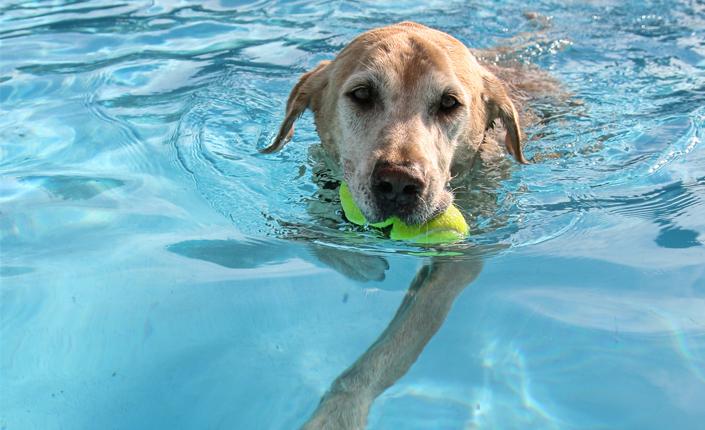
Top 10 Pet Pool & Swim Safety Tips
07/20/16
Printer-friendly version
It's the dog days of summer, and swimming is a great way for your pets to stay active and stay cool and maybe lose some extra winter weight. Before you let Fido or Fluffy take a dip, take a second and review these essential pool and swim safety tips!
- Give your pets swimming lessons. While your breed might be known for their abilities in the water, that doesn't necessarily mean they know how to swim. For both cats and dogs, gently bring them into the water with you and try holding their back ends up until they start to paddle away on their own. Don't expect them to get the hang of swimming on their first or even tenth try, so only attempt to teach them when you're in a patient mood.
- Teach them the way out. Once your pet can swim on its own, it is essential that they learn how to get in and out of the pool using the steps. Being able to identify the exit quickly is important so they can get out if they're tired or in a panic.
- Know their limits. If your pet can’t quite get the hang of swimming, know their limits and keep them away from water - letting them near the pool or unattended by the lake is not worth the risk.
- Accessorize. There are a number of products on the market that can help make your pet safer in and out of the water. Dog life jackets are great confidence boosters for pets just starting to swim and are essential for any boating adventures your dog joins in on. Water-detecting collars are available for both cats and dogs, and can alert you when the sensor gets wet. You can also make it easier for cats and dogs to get out of the pool using one of the many floating ramps or stairs on the market.
- Don't let them drink the pool water. Of course, any animal is sure to get some of the chlorinated water in their mouths while swimming, but keep an eye on any excessive drinking from the pool, lake or pond. Keep fresh water nearby and remove them from the water if necessary.
- Know CPR. There are pet CPR and first aid courses available. Hopefully, you never need to use these techniques, but you can take comfort knowing that you are as prepared as you can be for emergency situations.
- Don't over do it. Have a great time swimming with your pet but also be realistic about when it is time to get out of the water. Take breaks, hydrate and when either one of you starts getting tired, call it a day.
- Be aware of the side effects of swimming. Before you get in the water, know the signs of heat stroke in your pets. During the day, keep in mind the temperature and texture of the ground around the water to keep those pet paws in good shape. After you get out, keep an eye out for the signs of swimmer's ear such as redness, pain or odour.
- Check the water before you let them in. For your pet's sake and the safety of those humans who may already be splashing around, pay attention to water conditions or any debris that can be hazards to the fun.
- Be Prepared. Along with tip 9, consider the worst-case scenario before you dive-in. If water conditions become dangerous, who is the strongest (human) swimmer that can help retrieve any pets. Consider keeping a human life jacket nearby for emergencies. And always know the number for the local pet hospital.
You shouldn't be scared to get into the water with your pets, so taking a few extra precautions can put your mind at ease and let you focus on some splashy fun.
